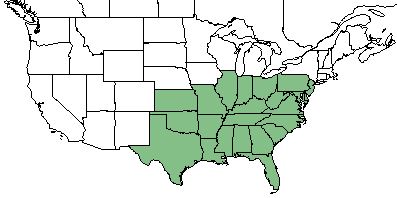Difference between revisions of "Passiflora incarnata"
(→Conservation and Management) |
|||
| Line 1: | Line 1: | ||
{{italic title}} | {{italic title}} | ||
| + | Common name: purple passionflower <ref name= "USDA Plant Database"/>, maypop <ref name= "Weakley 2015"/> | ||
<!-- Get the taxonomy information from the NRCS Plants database --> | <!-- Get the taxonomy information from the NRCS Plants database --> | ||
{{taxobox | {{taxobox | ||
Revision as of 10:15, 7 June 2018
Common name: purple passionflower [1], maypop [2]
| Passiflora incarnata | |
|---|---|

| |
| Photo by John Gwaltney hosted at Southeastern Flora.com | |
| Scientific classification | |
| Kingdom: | Plantae |
| Division: | Magnoliophyta - Flowering plants |
| Class: | Magnoliopsida - Dicots |
| Order: | Violales |
| Family: | Passifloraceae |
| Genus: | Passiflora |
| Species: | P. incarnata |
| Binomial name | |
| Passiflora incarnata L. | |

| |
| Natural range of Passiflora incarnata from USDA NRCS Plants Database. | |
Contents
Taxonomic Notes
Synonyms: none
Varieties: none
Description
P. incarnata is a perennial forb/herb/vine of the Passifloraceae family native to North America. [1]
Distribution
P. incarnata is found in the southeastern corner of the United States. [1]
Ecology
Habitat
P. incarnata proliferates in roadsides, fencerows, thickets, and fields. [2]
Phenology
P. incarnata flowers April-August and October. [3]
Conservation and Management
P. incarnata is listed as rare by the Indiana Department of Natural Resources Division of Nature Preserves, as threatened by the Ohio Department of Natural Resources Division of Natural Areas and Preserves, and as a weedy or invasive species by the University Press of Kentucky and the Southern Weed Science Society. [1]
Cultivation and restoration
Photo Gallery
References and notes
- ↑ 1.0 1.1 1.2 1.3 USDA Plant Database https://plants.usda.gov/core/profile?symbol=PAIN6
- ↑ 2.0 2.1 Weakley, A. S. (2015). Flora of the Southern and Mid-Atlantic States. Chapel Hill, NC, University of North Carolina Herbarium.
- ↑ PanFlora Author: Gil Nelson URL: http://www.gilnelson.com/PanFlora/ Date Accessed: 5/24/18